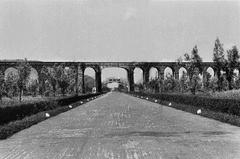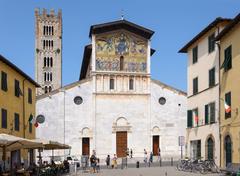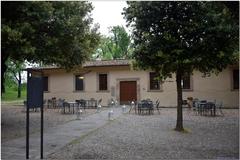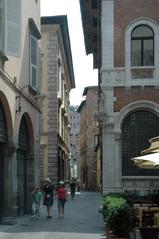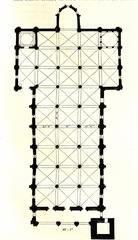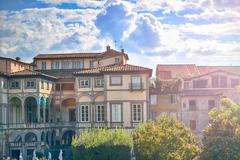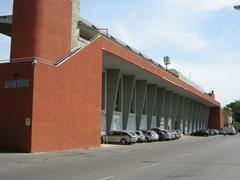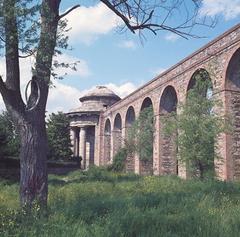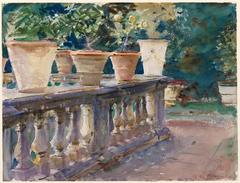Comprehensive Guide to Visiting Lucca, Province of Lucca, Italy
Date: 14/08/2024
Discover the Hidden Charms of Lucca
Welcome to Lucca, a city that feels like stepping into a storybook where medieval charm and modern vibrancy dance hand in hand. Nestled in the heart of Tuscany, Lucca’s ancient walls whisper secrets, and each cobblestone has a story to tell. Imagine strolling through time, from the Etruscan roots and Roman roads to the Renaissance walls designed by Leonardo da Vinci himself (Savoring Italy). Picture the medieval hustle along Via Francigena or envision the bustling heart of ancient Rome in Piazza San Michele (Britannica) and you’ll get a sense of Lucca’s rich tapestry of history and culture. Known for its resilience and transformation, Lucca has seen rulers come and go but has always retained its unique character and charm. Whether you’re cycling atop its magnificent walls or savoring local culinary delights, Lucca offers a magical journey through time. So, pack your curiosity and get ready to uncover the hidden gems and local secrets of this timeless Tuscan treasure.
Explore Lucca Like a Local - Table of Contents
- Unveiling Lucca: A Timeless Gem in Tuscany
- An Ancient Legacy: Etruscan Roots to Roman Roads
- Middle Ages: From Lombard Lords to Frankish Counts
- Renaissance Magic: Silk, Freedom, and Leonardo’s Walls
- Napoleonic Drama and Italian Unity
- Architectural Wonders and Cultural Riches
- Insider Tips and Hidden Treasures
- Seasonal Wonders and Local Customs
- Introduction to Lucca’s Timeless Allure
- Historical Significance
- Ancient and Medieval History
- Renaissance and Beyond
- Architectural Heritage
- Cultural Significance
- Music and Festivals
- Art and Architecture
- Visitor Tips
- Exploring the City Walls
- Key Attractions
- Off the Beaten Path
- Culinary Delights
- Practical Information
- Local Insights
Unveiling Lucca: A Timeless Gem in Tuscany
An Ancient Legacy: Etruscan Roots to Roman Roads
Lucca’s name might mean ‘sacred grove’ or ‘luminous space’. This charming city, nestled in Tuscany, was first settled by the Etruscans and possibly even earlier by the Ligurians. Fast forward to 180 BCE, and the Romans roll in, establishing a colony and stamping their grid pattern on the city. Wander around Piazza San Michele and imagine it as the bustling heart of ancient Rome, or stroll through Piazza dell’Anfiteatro, where the whispers of gladiators still echo (Wikipedia).
Middle Ages: From Lombard Lords to Frankish Counts
Lucca’s story is one of power plays and shifting rulers. The Goths, Byzantines, and Lombards all left their mark until the 6th century, when Lucca shone as the leading city of the Lombard Duchy of Tuscia (Savoring Italy). The medieval hustle and bustle along the Via Francigena, a vital route connecting Lombardy and Rome, was a defining feature (Britannica). Even as Florence began to rise, Lucca held its ground with grace.
Renaissance Magic: Silk, Freedom, and Leonardo’s Walls
Constant conflicts couldn’t dim Lucca’s shine. This resilient city thrived, especially in the silk trade, securing a charter of liberties in 1118 and creating a commune (Italy This Way). The Renaissance walls, designed by none other than Leonardo da Vinci, still stand proudly today (Savoring Italy). These walls are more than just stones; they tell tales of independence and ingenuity.
Napoleonic Drama and Italian Unity
Enter the French in 1799, and Lucca’s scene changes again. From 1805 to 1814, Napoleon’s sister Élisa Baciocchi ruled as princess. Post-Congress of Vienna, Lucca passed through royal hands until joining the unified Kingdom of Italy in 1860 (Britannica). Despite these twists and turns, Lucca’s historical essence remains unscathed.
Architectural Wonders and Cultural Riches
Lucca is a living museum, with its medieval and Renaissance buildings whispering stories of yore. The Guinigi Tower, with its rooftop garden, offers breathtaking views and a touch of whimsy (PlanetWare). The Cathedral of San Martino, with its Romanesque façade and the mystical Volto Santo, is a must-see (The Crazy Tourist). Lucca also birthed musical legends like Giacomo Puccini. Visit his birthplace and let the melodies of history sweep you away (Wikipedia).
Insider Tips and Hidden Treasures
For insider tips, start with a leisurely walk or cycle atop the Renaissance walls for a panoramic view of Lucca’s beauty (Momin Italy). Dive into the historic center on foot to uncover gems like Piazza dell’Anfiteatro, Guinigi Tower, and the stunning Cathedral of San Martino (The Crazy Tourist). Lucca’s culinary scene awaits with Tuscan delights, from hearty pastas to exquisite pastries (Go Ask a Local).
Seasonal Wonders and Local Customs
Each season brings a new charm to Lucca. Spring blossoms, summer festivals, autumn’s golden hues, and winter’s cozy warmth – there’s always something magical happening. Embrace local customs and join in the festivities for an authentic Lucca experience.
Introduction to Lucca’s Timeless Allure
Welcome to Lucca, a city where ancient walls whisper secrets, and every cobblestone has a story to tell. Nestled in the heart of Tuscany, Lucca is a treasure trove of history, culture, and enchantment waiting to be discovered.
Historical Significance
Ancient and Medieval History
Lucca might have started as a Ligurian or Etruscan settlement. By 180 B.C., it had become a Roman colony, a fortress of strategic importance. Wander through the ages as you stroll down Via Francigena, a medieval pilgrimage route leading to the Church of San Martino, home to the fabled Holy Face (Italia.it).
Renaissance and Beyond
Imagine a city reclaiming its independence in 1370 thanks to Emperor Charles IV, only to later become a duchy under Maria Luisa of Bourbon. Lucca’s journey from a republic to joining the Kingdom of Italy in 1860 is a tale of resilience and transformation (Italia.it).
Architectural Heritage
Walking or cycling atop Lucca’s medieval walls, built in the 16th and 17th centuries, offers panoramic views that transport you back in time. These intact fortifications are a marvel. Don’t miss the Cathedral of San Martino with its intricate marble interiors (TraveltoItalyGuide).
Cultural Significance
Music and Festivals
Lucca isn’t just a visual feast; it’s a symphony. Birthplace of Giacomo Puccini, the city celebrates with the annual Puccini Festival. Visit his childhood home, now a museum, and let the music lead you through the streets (TraveltoItalyGuide). Festivals like the Lucca Summer Festival and Lucca Comics & Games infuse the city with vibrant energy (Italian Traditions).
Art and Architecture
Lucca’s Piazza dell’Anfiteatro, with its unique elliptical shape, is a living gallery of Roman heritage. Marvel at the Church of San Michele in Foro and its layers of loggias, or the Lombard charm of Chiesa di San Frediano (TraveltoItalyGuide).
Visitor Tips
Exploring the City Walls
Walk or cycle along the 4-kilometer stretch of Lucca’s walls. Feel the centuries beneath your feet as you enjoy a unique perspective of the city (Travelsewhere).
Key Attractions
- Lucca Cathedral (Duomo di San Martino): A masterpiece of Romanesque architecture, rich with art and history (Wikipedia).
- Guinigi Tower: Climb this 1384 marvel for breathtaking city views (Wikipedia).
- Piazza dell’Anfiteatro: A charming square built on ancient Roman remains (TraveltoItalyGuide).
Off the Beaten Path
- Ponte del Diavolo (Devil’s Bridge): Steeped in legend, this picturesque bridge is a must-see (Italia.it).
- Volto Santo of Lucca: The striking wooden crucifix in the Cathedral of San Martino (Italia.it).
Culinary Delights
Savor the flavors of Lucca with dishes like Tordelli Lucchesi, a stuffed pasta, and Buccellato, a sweet anise bread (Italia.it).
Practical Information
- Getting There: Easily accessible by train from Florence or Pisa, and well-connected by bus.
- Accommodation: From budget to luxury, book in advance during festival seasons.
- Best Time to Visit: Spring and autumn offer pleasant weather and fewer crowds.
Local Insights
Embrace the local charm as you stroll narrow, nearly car-free streets, and mingle in cozy cafes (Travelsewhere).
Discovering Lucca: A Whimsical Journey Through Tuscany’s Hidden Gem
Welcome to Lucca
Nestled in the heart of Tuscany, Lucca is a city where medieval charm meets modern vibrancy. Imagine strolling along ancient walls, sipping espresso in quaint piazzas, and discovering stories etched in stone.
Best Time to Visit
Lucca is a year-round delight, but if you want to experience it at its finest, aim for spring (March to May) or fall (September to November). Enjoy mild temperatures perfect for cycling around the city walls, with blooming flowers in spring or golden leaves in fall as your backdrop. Summer brings the heat (up to 86°F), but also a plethora of cultural events like the Lucca Summer Festival. Winter, though quieter, has its own charm with festive decorations and cozy, warm cafes (Savoring Italy).
Getting Around
Forget driving; Lucca is best explored on foot or by bike. Rent a bicycle from local shops and pedal along the tree-lined Renaissance walls. Walking is equally enchanting, with every twist and turn revealing a new piece of history (The Belle Voyage).
Accommodation
From opulent hotels to charming B&Bs, Lucca’s accommodations are as varied as its history. Consider staying within the city walls for easy access to all attractions. The Hotel Ilaria offers modern comforts in a central location, while Palazzo Dipinto combines historical elegance with boutique style (PlanetWare).
Key Attractions
Le Mura di Lucca (The Lucca Walls)
These Renaissance walls, now a public park, are Lucca’s crown jewel. Walk, jog, or cycle the 4.2-kilometer path and soak in panoramic views of the city and countryside. It’s a daily parade of locals and tourists alike, enjoying the best of Lucca’s past and present (Tourist Italy).
Torre Guinigi
Climb the 230 steps of this 14th-century tower to find a rooftop garden with ancient holm oaks. The view? Simply breathtaking—a 360-degree panorama of Lucca and the Tuscan hills (PlanetWare).
Piazza Anfiteatro
Step into history at this elliptical piazza, built on the ruins of a Roman amphitheater. Today, it’s a bustling hub for shopping, dining, and people-watching. Spot the original amphitheater walls and imagine the gladiators of old (The Belle Voyage).
Lucca Cathedral (Duomo di San Martino)
In Piazza San Martino, the cathedral is a feast for the eyes with its Romanesque facade and intricate interiors. Don’t miss the Volto Santo, a revered wooden crucifix, and the tomb of Ilaria del Carretto, a sculptural masterpiece (The Crazy Tourist).
Cultural Events
Lucca’s calendar is packed with cultural festivals. July’s Lucca Summer Festival brings international artists to Piazza Napoleone, while the Lucca Comics & Games, held in late October and early November, is a paradise for comic and game enthusiasts (Nomads Travel Guide).
Shopping
Via Fillungo is your go-to for a mix of high-end boutiques and local artisan shops. For something unique, explore the antique market in Piazza San Giusto and Piazza Antelminelli on the third weekend of each month (Savoring Italy).
Dining
Prepare your taste buds for Lucca’s culinary delights. Try tortelli lucchesi (stuffed pasta) and buccellato (sweet bread with raisins and aniseed). Top spots? Trattoria da Leo for authentic Tuscan fare and Ristorante Giglio for a fine dining experience in a historic setting (The Belle Voyage).
Day Trips
Lucca is a perfect base for exploring Tuscany. Check out these nearby gems:
- Pisa: Just 30 minutes away, famous for its Leaning Tower and the stunning Piazza dei Miracoli (Tourist Italy).
- San Gimignano: An hour’s drive to see medieval towers and taste Vernaccia wine (Savoring Italy).
- Volterra: 1.5 hours away, known for its Etruscan, Roman, and medieval architecture, and alabaster shops (Savoring Italy).
- Carrara: An hour north, famous for its marble quarries. Take a tour and see where Michelangelo sourced his marble (Savoring Italy).
Practical Tips
- Language: Italian is the official language, but English is widely spoken in tourist areas.
- Currency: Euro (€). Credit cards are accepted, but carry some cash for small purchases.
- Safety: Lucca is generally safe, but stay aware of your surroundings and belongings.
- Local Etiquette: Politeness is key. A simple “Buongiorno” or “Buonasera” goes a long way. Dress modestly in churches.
- Opening Hours: Many shops and restaurants close from 1 PM to 4 PM. Plan accordingly.
Unlock Lucca’s Secrets with Audiala
Ready to explore Lucca like a local? Download Audiala, your ultimate tour guide app, for expertly crafted audio guides that reveal hidden gems and fascinating stories. Dive deeper into Lucca’s rich history and vibrant culture with Audiala—your perfect travel companion.
Unlock Lucca’s Secrets with Audiala - Your Perfect Travel Companion
As you wrap up your whimsical journey through the enchanting streets of Lucca, it becomes clear that this city is a living museum of history, culture, and charm. From the ancient layers of its Roman roots to the bustling medieval marketplaces and the Renaissance fortifications, Lucca stands as a testament to resilience and beauty (Italia.it). Whether you’ve marveled at the panoramic views from Guinigi Tower or lost yourself in the melodies of Puccini, Lucca offers an immersive experience that engages all your senses. Its seasonal wonders, vibrant festivals, and culinary delights ensure that there’s always something new to discover. So, what are you waiting for? Dive deeper into Lucca’s rich history and vibrant culture with Audiala, your ultimate tour guide app. Download Audiala and unlock the city’s secrets and stories for an unforgettable journey through Tuscany’s hidden gem. Buon viaggio!
Resources and Inspirations
- Unveiling Lucca: A Timeless Gem in Tuscany (Wikipedia)
- Savoring Italy (Savoring Italy)
- Britannica (Britannica)
- Italy This Way (Italy This Way)
- PlanetWare (PlanetWare)
- The Crazy Tourist (The Crazy Tourist)
- Go Ask a Local (Go Ask a Local)
- Italia.it (Italia.it)
- TraveltoItalyGuide (TraveltoItalyGuide)
- Travelsewhere (Travelsewhere)
- Italian Traditions (Italian Traditions)
- Nomads Travel Guide (Nomads Travel Guide)
- The Belle Voyage (The Belle Voyage)
- Tourist Italy (Tourist Italy)


